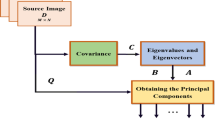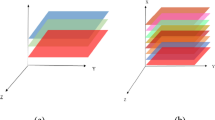Abstract
In recent times, the fusion of spatial relaxation with spectral data has achieved remarkable success in target classification methods. Spatial relaxation is a scheme which exploits the neighbourhood relationship between the pixels of an image to minimize the spatio-spectral distortion. Application of spatial relaxation with spectral data can lead to reduce the noise effect and increase the class characterization. Such methods can also be applied to estimate the posteriors of the probabilistic classifier, to increase the classifier’s final accuracy. In this paper, we have introduced an edge based feature fusion method which helps in characterizing the class labels of hyperspectral image (HSI) in a better sense. It is an iterative method which exploits the spatial information from an image in such a manner that it assumes the feature preservation in vertical and horizontal directions for each pixel. With combining subspace regression based probabilistic method, the proposed method gives better accuracy for benchmark HSI datasets. Before this, we have implemented a fast Bayesian subspace regression method to achieve the posterior probabilities, for our edge feature relaxation method. Finally, we have compared the results with some recently proposed methods, and \(\alpha \) expansion graph cut optimization method, which is an efficient technique to fuse the contextual knowledge in posterior probabilities.















Similar content being viewed by others
References
Aviris-NASA(JPL) HD. Indian pines and Salinas Valley datasets. https://aviris.jpl.nasa.gov/. Accessed 20 Jan 2019.
Bagan, H., Yasuoka, Y., Endo, T., Wang, X., & Feng, Z. (2008). Classification of airborne hyperspectral data based on the average learning subspace method. IEEE Geoscience and Remote Sensing Letters, 5(3), 368–372. https://doi.org/10.1109/LGRS.2008.915941.
Bandos, T. V., Bruzzone, L., & Camps-Valls, G. (2009). Classification of hyperspectral images with regularized linear discriminant analysis. IEEE Transactions on Geoscience and Remote Sensing, 47(3), 862–873. https://doi.org/10.1109/TGRS.2008.2005729.
Borges, J. S., Marcal, A. R. S., & Bioucas-Dias, J. M. (2007). Evaluation of bayesian hyperspectral image segmentation with a discriminative class learning. In 2007 IEEE International Geoscience and Remote Sensing Symposium (pp. 3810–3813). https://doi.org/10.1109/IGARSS.2007.4423673.
Camps-Valls, G., Gomez-Chova, L., Munoz-Mari, J., Vila-Frances, J., & Calpe-Maravilla, J. (2006). Composite kernels for hyperspectral image classification. IEEE Geoscience and Remote Sensing Letters, 3(1), 93–97. https://doi.org/10.1109/LGRS.2005.857031.
Cao, X., Zhou, F., Xu, L., Meng, D., Xu, Z., & Paisley, J. (2018). Hyperspectral image classification with markov random fields and a convolutional neural network. IEEE Transactions on Image Processing, 27(5), 2354–2367. https://doi.org/10.1109/TIP.2018.2799324.
Chambolle, A. (2004). An algorithm for total variation minimization and applications. Journal of Mathematical Imaging and Vision, 20(1–2), 89–97. https://doi.org/10.1023/B:JMIV.0000011325.36760.1e.
Chang, C. I. (2005). Orthogonal subspace projection (osp) revisited: A comprehensive study and analysis. IEEE Transactions on Geoscience and Remote Sensing, 43(3), 502–518. https://doi.org/10.1109/TGRS.2004.839543.
Chen, J., Du, L., Li, J., Han, Y., & Gao, Z. (2017). Improved algorithm for hyperspectral data dimension determination. IOP Conference Series: Earth and Environmental Science, 57(1), 012044.
Cheng, G., Li, Z., Han, J., Yao, X., & Guo, L. (2018). Exploring hierarchical convolutional features for hyperspectral image classification. IEEE Transactions on Geoscience and Remote Sensing, 56(11), 6712–6722. https://doi.org/10.1109/TGRS.2018.2841823.
Devika, S., & Chaitanya, S. M. K. (2016). Signal estimation of hyperspectral data using hysime algorithm. In 2016 International conference on research advances in integrated navigation systems (RAINS) (pp. 1–3). https://doi.org/10.1109/RAINS.2016.7764372.
Du, Q., & Younan, N. H. (2008). On the performance improvement for linear discriminant analysis-based hyperspectral image classification. In 2008 IAPR workshop on pattern recognition in remote sensing (PRRS 2008) (pp. 1–4). https://doi.org/10.1109/PRRS.2008.4783168.
Dubes, R. C., Jain, A. K., Nadabar, S. G., & Chen, C. C. (1990). Mrf model-based algorithms for image segmentation. In Proceedings of the 10th international conference on pattern recognition (vol i, pp. 808–814). https://doi.org/10.1109/ICPR.1990.118221.
Gamba, P. P. Pavai university Rosis dataset. http://www.ehu.eus/ccwintco/index.php/Hyperspectral_Remote_Sensing_Scenes. Accessed 20 Jan 2019.
Ghamisi, P., Benediktsson, J. A., & Sveinsson, J. R. (2014). Automatic spectral-spatial classification framework based on attribute profiles and supervised feature extraction. IEEE Transactions on Geoscience and Remote Sensing, 52(9), 5771–5782. https://doi.org/10.1109/TGRS.2013.2292544.
Gonzalez, C., Lopez, S., Mozos, D., & Sarmiento, R. (2015). Fpga implementation of the hysime algorithm for the determination of the number of endmembers in hyperspectral data. IEEE Journal of Selected Topics in Applied Earth Observations and Remote Sensing, 8(6), 2870–2883. https://doi.org/10.1109/JSTARS.2015.2425731.
Hahn, J., Wu, C., & Tai, X. C. (2012). Augmented lagrangian method for generalized tv-stokes model. Journal of Scientific Computing, 50(2), 235–264. https://doi.org/10.1007/s10915-011-9482-6.
Hu, W., Huang, Y., Wei, L., Zhang, F., & Li, H. (2015). Deep convolutional neural networks for hyperspectral image classification. Journal of Sensors, 258619, 12. https://doi.org/10.1155/9161.
Huang, X., Lu, Q., Zhang, L., & Plaza, A. (2014a). New postprocessing methods for remote sensing image classification: A systematic study. IEEE Transactions on Geoscience and Remote Sensing, 52(11), 7140–7159. https://doi.org/10.1109/TGRS.2014.2308192.
Huang, X., Lu, Q., Zhang, L., & Plaza, A. (2014b). New postprocessing methods for remote sensing image classification: A systematic study. IEEE Transactions on Geoscience and Remote Sensing, 52(11), 7140–7159. https://doi.org/10.1109/TGRS.2014.2308192.
Jia, X., & Richards, J. A. (2008). Managing the spectral-spatial mix in context classification using markov random fields. IEEE Geoscience and Remote Sensing Letters, 5(2), 311–314. https://doi.org/10.1109/LGRS.2008.916076.
Krishnapuram, B., Carin, L., Figueiredo, M. A. T., & Hartemink, A. J. (2005). Sparse multinomial logistic regression: Fast algorithms and generalization bounds. IEEE Transactions on Pattern Analysis and Machine Intelligence, 27(6), 957–968. https://doi.org/10.1109/TPAMI.2005.127.
Li, S. (2001). Markov random field modeling in image analysis. https://doi.org/10.1007/978-1-84800-279-1.
Li, J., Khodadadzadeh, C., Plaza, A., & Jia, X. (2016). A discontinuity preserving relaxation scheme for spectral spatial hyperspectral image classi cation. IEEE Journal of Selected Topics in Applied Earth Observations and Remote Sensing, 9(2), 625–681. https://doi.org/10.1109/JSTARS.2015.2470129.
Li, F., Xin, L., Guo, Y., Gao, J., & Jia, X. (2017). A framework of mixed sparse representations for remote sensing images. IEEE Transactions on Geoscience and Remote Sensing, 55(2), 1210–1221. https://doi.org/10.1109/TGRS.2016.2621123.
Li, W., Wu, G., Zhang, F., & Du, Q. (2017a). Hyperspectral image classification using deep pixel-pair features. IEEE Transactions on Geoscience and Remote Sensing, 55(2), 844–853. https://doi.org/10.1109/TGRS.2016.2616355.
Liu, J., Wu, Z., Xiao, Z., & Yang, J. (2017). Region-based relaxed multiple kernel collaborative representation for hyperspectral image classification. IEEE Access, 5, 20921–20933. https://doi.org/10.1109/ACCESS.2017.2758168.
Lloyd, S. (1983). An optimization approach to relaxation labelling algorithms. Image and Vision Computing, 1(2), 85–91.
Moser, G., & Serpico, S. B. (2013). Combining support vector machines and markov random fields in an integrated framework for contextual image classification. IEEE Transactions on Geoscience and Remote Sensing, 51(5), 2734–2752. https://doi.org/10.1109/TGRS.2012.2211882.
Mura, M. D., Benediktsson, J. A., Waske, B., & Bruzzone, L. (2010). Extended profiles with morphological attribute filters for the analysis of hyperspectral data. International Journal of Remote Sensing, 31(22), 5975–5991. https://doi.org/10.1080/01431161.2010.512425.
Pelkowitz, L. (1990). A continuous relaxation labeling algorithm for markov random fields. IEEE Transactions on Systems, Man, and Cybernetics, 20(3), 709–715. https://doi.org/10.1109/21.57279.
Perona, P., & Malik, J. (1990). Scale-space and edge detection using anisotropic diffusion. IEEE Transactions on Pattern Analysis and Machine Intelligence, 12(7), 629–639. https://doi.org/10.1109/34.56205.
Richards, J. A. (1999). Remote sensing digital image analysis: An introduction. Berlin: Springer.
Richards, J. A., Landgrebe, D. A., & Swain, P. H. (1981). Pixel labeling by supervised probabilistic relaxation. IEEE Transactions on Pattern Analysis and Machine Intelligence PAMI, 3(2), 188–191.
Rodriguez-Cuenca, B., Malpica, J. A., & Alonso, M. C. (2013). A spatial contextual postclassification method for preserving linear objects in multispectral imagery. IEEE Transactions on Geoscience and Remote Sensing, 51(1), 174–183. https://doi.org/10.1109/TGRS.2012.2197756.
Serpico, S. B., & Moser, G. (2007). Extraction of spectral channels from hyperspectral images for classification purposes. IEEE Transactions on Geoscience and Remote Sensing, 45(2), 484–495. https://doi.org/10.1109/TGRS.2006.886177.
Song, W., Li, S., Kang, X., & Huang, K. (2016). Hyperspectral image classification based on KNN sparse representation. In 2016 IEEE international geoscience and remote sensing symposium (IGARSS) (pp. 2411–2414). https://doi.org/10.1109/IGARSS.2016.7729622.
Sun, L., Wu, Z., Liu, J., & Wei, Z. (2013a). Supervised hyperspectral image classification using sparse logistic regression and spatial-tv regularization. In 2013 IEEE international geoscience and remote sensing symposium-IGARSS (pp. 1019–1022). https://doi.org/10.1109/IGARSS.2013.6721336
Sun, L., Wu, Z., Liu, J., & Wei, Z. (2013b). Supervised hyperspectral image classification using sparse logistic regression and spatial-tv regularization. In 2013 IEEE international geoscience and remote sensing symposium-IGARSS (pp. 1019–1022). https://doi.org/10.1109/IGARSS.2013.6721336.
Sun, L., Wu, Z., Liu, J., Xiao, L., & Wei, Z. (2015a). Supervised spectral-spatial hyperspectral image classification with weighted Markov random fields. IEEE Transactions on Geoscience and Remote Sensing, 53(3), 1490–1503. https://doi.org/10.1109/TGRS.2014.2344442.
Sun, L., Wu, Z., Liu, J., Xiao, L., & Wei, Z. (2015b). Supervised spectral-spatial hyperspectral image classification with weighted Markov random fields. IEEE Transactions on Geoscience and Remote Sensing, 53(3), 1490–1503. https://doi.org/10.1109/TGRS.2014.2344442.
Sun, G., Zhang, A., Ren, J., Ma, J., Wang, P., Zhang, Y., et al. (2017). Gravitation-based edge detection in hyperspectral images. Remote Sensing, 9(6), 592. https://doi.org/10.3390/rs9060592.
Tarabalka, Y., Benediktsson, J. A., & Chanussot, J. (2009). Spectral-spatial classification of hyperspectral imagery based on partitional clustering techniques. IEEE Transactions on Geoscience and Remote Sensing, 47(8), 2973–2987. https://doi.org/10.1109/TGRS.2009.2016214.
Tarabalka, Y., Fauvel, M., Chanussot, J., & Benediktsson, J. A. (2010a). Svm- and mrf-based method for accurate classification of hyperspectral images. IEEE Geoscience and Remote Sensing Letters, 7(4), 736–740. https://doi.org/10.1109/LGRS.2010.2047711.
Tarabalka, Y., Fauvel, M., Chanussot, J., & Benediktsson, J. A. (2010b). SVM- and MRF-based method for accurate classification of hyperspectral images. IEEE Geoscience and Remote Sensing Letters, 7(4), 736–740. https://doi.org/10.1109/LGRS.2010.2047711.
Tian, Y., Guo, P., & Lyu, M. (2005). Comparative studies on feature extraction methods for multispectral remote sensing image classification. https://doi.org/10.1109/ICSMC.2005.1571322.
Velasco-Forero, S., & Manian, V. (2009). Improving hyperspectral image classification using spatial preprocessing. IEEE Geoscience and Remote Sensing Letters, 6(2), 297–301. https://doi.org/10.1109/LGRS.2009.2012443.
Wang, Y., Niu, R., & Yu, X. (2010). Anisotropic diffusion for hyperspectral imagery enhancement. IEEE Sensors Journal, 10(3), 469–477. https://doi.org/10.1109/JSEN.2009.2037800.
Waske, B., van der Linden, S., Benediktsson, J. A., Rabe, A., & Hostert, P. (2010). Sensitivity of support vector machines to random feature selection in classification of hyperspectral data. IEEE Transactions on Geoscience and Remote Sensing, 48(7), 2880–2889. https://doi.org/10.1109/TGRS.2010.2041784.
Yan, Q., Ding, Y., Zhang, J. J., Xun, L. N., & Zheng, C. H. (2018). Approximate sparse spectral clustering based on local information maintenance for hyperspectral image classification. PLOS ONE, 13(8), 1–15. https://doi.org/10.1371/journal.pone.0202161.
Yang, J., Kuo, B., Yu, P., & Chuang, C. (2010). A dynamic subspace method for hyperspectral image classification. IEEE Transactions on Geoscience and Remote Sensing, 48(7), 2840–2853. https://doi.org/10.1109/TGRS.2010.2043533.
Yıldırım, I., Ersoy, O. K., & Yazgan, B. (2005). Improvement of classification accuracy in remote sensing using morphological filter. Advances in Space Research, 36(5), 1003–1006. https://doi.org/10.1016/j.asr.2005.05.043. (atmospheric Remote Sensing: Earth’s Surface, Troposphere, Stratosphere and Mesosphere-I) .
Zhang, B., Li, S., Jia, X., Gao, L., & Peng, M. (2011). Adaptive Markov random field approach for classification of hyperspectral imagery. IEEE Geoscience and Remote Sensing Letters, 8(5), 973–977. https://doi.org/10.1109/LGRS.2011.2145353.
Zhang, X., Pan, Z., Lu, X., Hu, B., & Zheng, X. (2018). Hyperspectral image classification based on joint spectrum of spatial space and spectral space. Multimedia Tools and Applications, 77(22), 29759–29777. https://doi.org/10.1007/s11042-017-5552-6.
Zhao, B., Gao, L., Liao, W., & Zhang, B. (2017a). A new kernel method for hyperspectral image feature extraction. Geo-spatial Information Science, 20(4), 309–318. https://doi.org/10.1080/10095020.2017.1403088.
Zhao, B., Gao, L., Liao, W., & Zhang, B. (2017b). A new kernel method for hyperspectral image feature extraction. Geo-spatial Information Science, 20(4), 309–318. https://doi.org/10.1080/10095020.2017.1403088.
Zhu, J., Li, K., & Hao, B. (2018). Image restoration by a mixed high-order total variation and regularization model. Hindawi Mathematical Problems in Engineering, 2018, 13.
Acknowledgements
We have shown the impact of EPS based method on different bands of real HSI. Graphcut (GC) optimization has performed with the help of C++ wrapper libraries provided by shai bagon. Indiana Pines, Salinas Valley, and Pavia University data is obtained from [Aviris-NASA (JPL); Gamba (Accessed: 2019-01-20)] while spectral signatures for the synthetic data set has obtained from USGS spectroscopy lab. Figure 15 shows the band-wise features obtained by using EPS method on HSI.
Author information
Authors and Affiliations
Corresponding author
Additional information
Publisher's Note
Springer Nature remains neutral with regard to jurisdictional claims in published maps and institutional affiliations.
Rights and permissions
About this article
Cite this article
Srivastava, V., Biswas, B. An efficient feature fusion in HSI image classification. Multidim Syst Sign Process 31, 221–247 (2020). https://doi.org/10.1007/s11045-019-00658-3
Received:
Revised:
Accepted:
Published:
Issue Date:
DOI: https://doi.org/10.1007/s11045-019-00658-3




